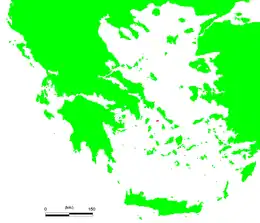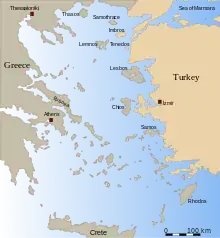Native name: Γυάρος or Γιούρα | |
|---|---|
 | |
 | |
| Geography | |
| Coordinates | 37°37′38″N 24°43′12″E / 37.62722°N 24.72000°E |
| Archipelago | Cyclades |
| Area | 23 km2 (8.9 sq mi) |
| Highest elevation | 489 m (1604 ft) |
| Highest point | Mt. Gyaros |
| Administration | |
Greece | |
| Region | Southern Aegean |
| Regional unit | Syros |
| Demographics | |
| Population | 0 (2001) |
| Additional information | |
| Postal code | 840 00 |
| Area code(s) | 228x0 |
| Vehicle registration | EM |
Gyaros (Greek: Γυάρος pronounced [ˈʝaros]), also locally known as Gioura (Greek: Γιούρα), is an arid, unpopulated, and uninhabited Greek island in the northern Cyclades near the islands of Andros and Tinos, with an area of 23 square kilometres (9 sq mi). It is a part of the municipality of Ano Syros, which lies primarily on the island of Syros. This and other small islands of the Aegean Sea served as places of exile for important persons in the early Roman empire. The extremity of its desolation was proverbial among Roman authors, such as Tacitus and Juvenal. It was a place of exile for left-wing political dissidents in Greece from 1948 until 1974. During that time, at least 22,000 people were exiled or imprisoned on the island.[1] It is an island of great ecological importance as it hosts the largest population of monk seals in the Mediterranean.[2]
Mythology and early history
The pseudo-Aristotelian work On Marvellous Things Heard (25) recounts the tale that on Gyaros the mice eat iron.
In the Aeneid of Virgil, Gyaros and Mykonos are said to be the two islands to which the god Apollo tied the holy island of Delos to stop its wandering over the Aegean Sea.[3] In his recounting of the myth of the war between Minos and Aegeus, the king of Athens, the poet Ovid speaks of Gyaros as one island that refused to join the campaign of the Cretan king.[4]
In 29 BC, the historian and geographer Strabo had an extended stay on the island, on his way to Corinth.
In the 1st century AD, Pliny the Elder wrote in his Natural History that the island, which had a city, was 15 miles (24 km) in circumference and lay 62 miles (100 km) from Andros.[5] He also records that the inhabitants of Gyaros were once put to flight by (a plague of) mice.[6] The island is also mentioned by the Roman orator Cicero, and other notable Latin authors, indicating a broad awareness of Gyaros among the educated elite of the 1st century BC to the 2nd century AD.[7]
Exile island during the early Roman Empire
The island (Latin: Gyaros or Gyara) also served as a place of exile during the early Roman Empire. Writing in the early 2nd century AD, the Roman historian Tacitus records that, when Silanus, the proconsul of the province of Asia, was accused of extortion and treason, and it had been proposed in the Roman Senate that he be exiled to Gyaros, the Roman Emperor Tiberius allowed him to be sent to the nearby island of Kythnos instead, since Gyaros was "harsh and devoid of human culture" (Annales 3.68-69).[8] When confronted with another recommendation to exile a defendant to Gyaros, Tiberius once more declined, noting that the island was deficient in water, and that those granted their lives ought to be granted the means to live (4.30). The defendant was allowed to go into exile on Amorgos instead.[9] The Roman poet Juvenal, a near-contemporary of Tacitus, mentions this island twice in his Satires: first as a place of exile for particularly vile criminals (1.73), and second as a symbol of claustrophobic imprisonment (10.170). In the second reference, Juvenal compares the restlessness of Alexander the Great to that of a man imprisoned:
|
Under emperor Nero, the philosopher Musonius Rufus was found guilty for his participation in the Pisonian conspiracy and was banished to Gyara.[10]
Exile island during the 20th century
There is a red brick prison building which during the years 1948 to 1953 held approximately 10,000 men in custody due to their participation in the Greek Resistance organization Ethniko Apeleftherotiko Metopo (EAM). Many of them were also involved in the Greek civil war (1945–1949). Jehovah's Witnesses were also sentenced to exile there as Christian conscientious objectors.
The prison was used again during the years 1967 to 1974 and during the Greek junta. The structures are decaying due to weathering, and no maintenance is conducted. In four separate places north of the prison building, there are also the ruins of the camps where the men lived in tents, both summer and winter. Once a year, the men and women who are alive and in good health (most of them were born between the 1910s and 1930s) who were formerly imprisoned on the island for their political views pay tribute by visiting the island and holding a ceremony in the cemetery of the men who left their last breath on this island.
The Greek government used the island as a target range for the Hellenic Navy until the year 2000. Currently the island is off-limits to the general public and approaching or fishing in close proximity is forbidden by the coast guard.
References
- ↑ Red Rocks of the Aegean: Greece's Prison Islands Archived 2014-02-02 at the Wayback Machine, New Histories March 15, 2012
- ↑ Karamanlidis, A.A.; et al. (April 2016). "The Mediterranean monk seal Monachus monachus: status, biology, threats, and conservation priorities". Mammal Review. 46 (2): 92–105. doi:10.1111/mam.12053.
- ↑
- Amid the sea a land is worshiped, a land most sacred
- to the mother of the Nereids and to Aegean Neptune,
- which, the dutiful bow-bearing god bound from Myconos
- and from steep Gyaros, as it wandered the shores and coasts,
- and he made it immobile and to have contempt for the winds.
- sacra mari colitur medio gratissima tellus
- Nereidum matri et Neptuno Aegaeo,
- quam pius arquitenens oras et litora circum
- errantem Mycono e celsa Gyaroque reuinxit,
- immotamque coli dedit et contemnere uentos.
- Aeneid 3.73-77
- ↑
- But Oliaros and Didyme and Tenos and Andros
- and Gyaros and Peparethos (bountiful in gleaming olives)
- did not assist the Knossian fleet; ...
- At non Oliaros Didymeque et Tenos et Andros
- et Gyaros nitidaeque ferax Peparethos olivae
- Cnosiacas iuvere rates; ...
- Metamorphoses 7.469-71
- ↑ Gyara cum oppido, circuitu XV, abest ab Andro LXII, ab ea Syrnos LXXX (NH 4.69). These are Roman miles, but his geography is still considerably in error.
- ↑ ex Gyara Cycladum insula incolas a muribus fugatos (NH 8.104). The visitors of the island can see many small pieces of pottery on the ground mostly in the river bed of the northernmost and bigger mini valley where the prisoners camp and its headquarters were located. No archaeological excavations have been conducted up to the year 2007. It is worth noting that there are remains of narrow terraces along the slopes of the eastern part of the island, proving that some rudimentary agriculture was driven in the past. Probably as back as the Prehistoric times used as refuge in times of raids by invading forces as well as the Roman times and later.
- ↑ Letters to Atticus 5.12.1
- ↑ ... addidit insulam Gyarum immitem et sine cultu hominum esse: In the Annales, Tiberius is portrayed as extraordinarily cruel and vengeful, making his hesitance to exile a criminal to Gyaros particularly pointed.
- ↑ id quoque aspernatus est, egenam aquae utramque insulam referens dandosque vitae usus cui vita concederetur. Serenus, a son prosecuting his own father without justification, was accused of attempted parricide, and the Senate recommended the old punishment of being thrown unto the Tiber river sewn in a bag with a snake, a dog, a rooster, and a monkey. Tiberius vetoed that proposal, and the Senate next proposed exile to Gyaros as a suitably terrible punishment.
- ↑ Tacitus, Annals, xv. 71; Cassius Dio, lxii. 27; Philostratus, Vit. Apoll., vii. 16
